|
|
|
|
 |
Marie Ellenrieder
|
|
Anna Marie Ellenrieder (March 20, 1791 - June 5, 1863, Konstanz) was a German painter.
She was born in Konstanz, Germany, the daughter of Konrad and Anna Maria Herrmann, and the granddaughter of Franz Ludwig Herrmann.
She studied under the miniature painter Joseph Einsle. Her portraits, similar in style to the ones of Angelica Kauffmann, made her the first woman to enter the Academy of Fine Arts Munich.
She spent the time between 1822 and 1824 in Rome, where she became a disciple of Friedrich Johann Overbeck. After this journey, she started painting religious topics such as "Christ Blessing Little Children" and "Mary and the Infant Jesus." Her two paintings "Der 12 jährige Jesus im Tempel / The 12 year old Jesus in the Temple", 1849 (oil on canvas, 203,2 x 139,7 cm) and "Hl Felicitas und ihre sieben Söhne / Holy Felicitas and her Seven Sons", 1847 (oil on canvas, 127 x 177,8 cm) were acquired by Queen Victoria who had been introduced to her work by the Prince Consort, who in turn had encountered the artist on his travels to Rome. They are now part of the Royal Collection in Osborne House.
She died in her home town of Konstanz. |
|
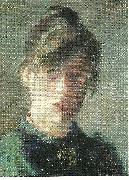 |
marie kroyer
|
|
(efter 1912 Alfven), född Triepcke 11 juni 1867 i Köpenhamn, död 25 maj 1940 i Stockholm, var en dansk konstnär, bosatt i Sverige från cirka 1905.
Marie Krøyer var 1889-1905 gift med konstnären Peder Severin Krøyer och hamnade i skuggan av hans konstnärskap. Själv kom hon att uppmärksammas som konstnär långt efter sin död. Hon levde ihop med den svenske tonsättaren Hugo Alfv??n från 1905 då de fick dottern Margita tillsammans; de gifte sig 1912 och skildes 1936 efter en lång rättsprocess. Paret var bosatta i Uppsala och Leksand. Marie hade också dottern Vibeke med Krøyer. |
|
 |
Marie Laurencin
|
|
French Painter, ca.1885-1956
French painter, stage designer and illustrator. After studying porcelain painting at the Sevres factory (1901) and drawing in Paris under the French flower painter Madelaine Lemaire (1845-1928), in 1903-4 she studied at the Academie Humbert in Paris, where she met Georges Braque and Francis Picabia. In 1907 she first exhibited paintings at the Salon des Independants, met Picasso at Clovis Sagot gallery and through Picasso was introduced to the poet Guillaume Apollinaire. Laurencin and Apollinaire were soon on intimate terms, their relationship lasting until 1912. |
|
 |
Marie Spartali Stillman
|
|
English Pre-Raphaelite Painter, 1844-1927
was a British Pre-Raphaelite painter of Greek descent, arguably the greatest female artist of that movement. During a sixty-year career she produced over one hundred works, contributing regularly to galleries in Great Britain and the United States. Maria Spartali was the youngest daughter of Michael Spartali, a wealthy merchant and Greek consul-general based in London, and his wife Euphrosyne. She and her cousins Maria Zambaco and Aglaia Coronio were known collectively among friends as "the Three Graces", after the Charites of Greek mythology (Aglaia, Euphrosyne and Thalia), as all three were noted beauties of Greek heritage. Swinburne said of Spartali: "She is so beautiful that I want to sit down and cry". Spartali studied under Ford Madox Brown for several years from 1864, with his children Lucy, Catherine and Oliver. She modelled for: Brown; Burne-Jones (The Mill); Julia Margaret Cameron; Rossetti (A Vision of Fiammetta, Dante's Dream, The Bower Meadow); Spencer Stanhope; and Whistler (La Princesse du Pays de la Porcelaine). In 1871, against her parents' wishes, she married American journalist and painter William J. Stillman. She was his second wife, his first having committed suicide two years before. His job as a foreign correspondent resulted in the couple dividing their time between London and Florence from 1878 to 1883, and then Rome from 1889 to 1896. |
|
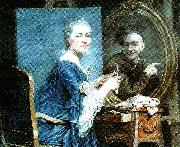 |
marie suzanne giroust roslin
|
|
Marie-Suzanne Giroust, född 9 mars 1734 i Paris, Frankrike, död 31 augusti 1772 i Paris, var en fransk konstnär, i huvudsak verksam inom pastellmåleri. Hon var gift med den svenske porträttmålaren Alexander Roslin från 1759 till sin död.
Dotter till Barthelemy Giroust och Marie Suzanne Leroy. När Giroust var sju år gammal, dog hennes far som var juvelerare. Fyra år senare dog även hennes mor, och hon flyttade in hos släktingar. Arvet efter fadern gav henne möjlighet att uppta målarstudier. Hon inledde sina studier hos Maurice Quentin de La Tour, men det var hos Joseph-Marie Vien hon kom att finna sig tillrätta. I Viens atelj?? träffade hon 1752 Alexander Roslin och blev förälskad. Girousts förmyndare kunde dock inte acceptera den svenske målaren som blivande make, då han var fattig och protestant.[1] Paret kämpade för sin kärlek, och Giroust vägrade att träffa de friare som hennes förmyndare föreslog för henne.[1] Efter medling av bland andra Roslins vän och beskyddare, Comte de Caylus, kunde Roslin och Giroust gifta sig, den 5 januari 1759. Paret Roslin fick mellan 1760 och 1772 sex barn, tre döttrar och tre söner, varav två döttrar och två söner nådde vuxen ålder.
Alexander Roslin erkände offentligen sin hustrus talang som konstnär, och han hävdade att hon var en skickligare pastellmålare än han själv. Giroust invaldes 1770 i den franska konstakademin, Acad??mie royale. 1771 utställde hon sitt porträtt av abb?? Lemonnier, som fick mycket beröm. Hon måladet i pastell.
Marie-Suzanne Giroust avled i bröstcancer i slutet av augusti 1772. |
|
|
|
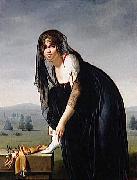 |
Marie-Denise Villers
|
|
(1774 - August 19, 1821) was a French painter, who specialized in portraits. She was born Marie-Denise Lemoine in Paris. She came from an artistic family, and her sisters Marie-Victoire Lemoine and Marie-Élisabeth Gabiou were also accomplished artists. In 1794, Marie-Denise married an architecture student, Michel-Jean-Maximilien Villers.
Villers was a student of the French painter Anne-Louis Girodet de Roussy-Trioson. She was first exhibited at the Paris Salon of the Year VII (1799). Villers' most famous painting, Young Woman Drawing, |
|
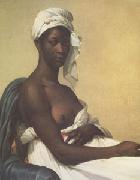 |
Marie-Guillemine Benoist
|
|
Paris 1768-1826
was a French neoclassical, historical and genre painter. She was born in Paris, the daughter of a civil servant. Her training as an artist began in 1781 under Élisabeth Vigee Le Brun, and she entered Jacques-Louis David's atelier in 1786 along with her sister Marie-Élisabeth Laville-Leroux. The poet Charles-Albert Demoustier, who met her in 1784, was inspired by her in creating the character Émile in his work Lettres Émilie sur la mythologie (1801). In 1791 she exhibited for the first time in the Salon de Paris, displaying her mythology-inspired picture Psych faisant ses adieux sa famille. Another of her paintings of this period, L'Innocence entre la vertu et le vice, is similarly mythological and reveals her feminist interests in this picture, vice is represented by a man, although it was traditionally represented by a woman. In 1793, she married the lawyer Pierre-Vincent Benoist. Her work, reflecting the influence of Jacques-Louis David, tended increasingly toward history painting by 1795. In 1800, she exhibited Portrait d'une negresse in the Salon. Six years previously, slavery had been abolished, and this image became a symbol for women's emancipation and black people's rights. This picture was acquired by Louis XVIII for France in 1818. An important commission, for a full-length portrait of Napol on Bonaparte Premier Consul Français in this period was awarded to her in 1803. This portrait was to be sent to the city of Ghent, newly ceded to France by the Treaty of Luneville in 1801. Other honors came to her; she was awarded a Gold Medal in the Salon of 1804, and received a governmental allowance. During this time she opened an atelier for the artistic training of women. Her career was harmed by political developments, however, when her husband, the convinced royalist count Benoist, was nominated in the Conseil d'État during the post-1814 monarchy come-back called the Bourbon Restoration. |
|
 |
MARIESCHI, Michele
|
|
Italian Painter, 1710-1743
Italian painter and engraver. His first biographers, Orlandi and Guarienti (1753), stated that Marieschi worked in Germany early in his career and then returned to Venice, where he established himself as a painter of 'beautiful views of the Grand Canal, and of churches and palaces'. Yet there is no other evidence for this journey and Marieschi's early training remains problematic. It seems likely that he began his career as a stage designer: his first recorded activity, in 1731, was the preparation, on behalf of the impresario Francesco Tasso ( fl 1725-c. 1740), of the setting for the Venetian celebration of Carnival Thursday in the Piazzetta. He then, influenced by Marco Ricci and Luca Carlevaris, began to paint capriccios and vedute. His early capriccios, such as the pair Capriccio with Classical Ruins and Bridge and Capriccio with Roman Arch and Encampment (mid-1730s; Naples, Mus. Civ. Gaetano Filangieri), are indebted to Ricci, although they lack his solemnity and magnificence. Marieschi's blend of medieval and Classical ruins in a serene Venetian landscape is more picturesque and romantic. Marieschi began to paint vedute having been encouraged by Canaletto's great success with the genre; examples such as the S Maria della Salute (1733-5; Paris, Louvre), the Piazzetta dei Leoni and the Grand Canal at Ca' Pesaro (1734-5; both Munich, Alte Pin.) are distinguished from Canaletto's work by their exaggerated perspective, more atmospheric colour and the spirited handling of the small figures. Two capriccios, the Town on a River with Rapids (London, N.G.) and the Town on a River with Shipping (London, N.G.;.), both charmingly picturesque scenes with watermills and crumbling towers, date from the mid-1730s. Marieschi began to etch in the 1730s, |
|
|
|
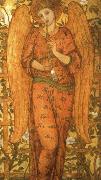 |
marin mersenne
|
|
French mathematician,philosopher and theorist. One of the leading French thinkers of the 17th century, he lived in Paris from 1619 as a Jesuit priest. His work is central to the academic and scientific movements of his time, and a major part of it is devoted to music. On the basis of practical experiment and observations, he made important discoveries concerning the nature and behaviour of sound, which are the foundation of the science of acoustics in later times. He also wrote on the theory and practice of music. His principal musical treatise is the Harmonie universelle |
|
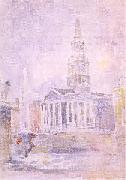 |
Marin, John
|
|
American Painter, 1870-1953
American painter and printmaker. He attended Stevens Institute in Hoboken, NJ, and worked briefly as an architect before studying at the Pennsylvania Academy of the Fine Arts in Philadelphia from 1899 to 1901 under Thomas Pollock Anshutz and Hugh Breckenridge (1870-1937). His education was supplemented by five years of travel in Europe where he was exposed to avant-garde trends. While abroad, he made etchings of notable and picturesque sites |
|
 |
Marinus van Reymerswaele
|
|
Flemish Northern Renaissance Painter, ca.1490-1567
South Netherlandish painter. He has been identified with Marino di Sirissea and with Marinus de Seeu, painter of Romerswaelen, mentioned respectively by Guicciardini and van Mander. He could quite possibly have been Moryn Claessone, native of Zeeland, who enrolled as a pupil of 'Simon the glassmaker' in the Antwerp Guild of St Luke in 1509. In that case he would have been born c. 1490-95. Claes van Ziericsee, an artist who became master of the Guild in 1475, is assumed to have been his father though this cannot be proved conclusively. Van Reymerswaele's work corresponds closely with Antwerp painting of the beginning of the 16th century |
|
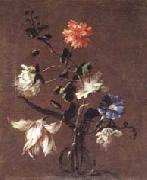 |
Mario Dei Fiori
|
|
Italian painter , Penna Fermana 1603- Rome 1673
Italian painter. He was the first and most famous Roman painter to specialize in flower-pieces and one of only four still-life artists included by Leone Pascoli in his collection of artists' biographies. The early sources and old inventories attribute many flower paintings in distinguished Roman collections to the Caravaggesque painter Tommaso Salini, and since the 18th century Mario's name has been linked with his, and it has been assumed that he trained with Salini. This apprenticeship is difficult to document, yet a comparison of Mario's pictures with inventory descriptions of works by Salini confirms that Mario was influenced by his art. To the minute observation of various kinds of flowers, Mario added a refined sense of design and an interest in effects of light, still linked to Caravaggio in the use of a dark background. |
|
|
|
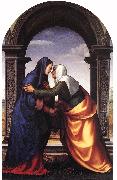 |
Mariotto Albertinelli
|
|
(October 13, 1474 - November 5, 1515) was a High Renaissance Italian painter of the Florentine school, closely involved with Fra Bartolomeo and influenced by Raphael.
He was born in Florence.
Already as a 12-year old boy, he became a pupil of Cosimo Rosselli, and a fellow-pupil with Fra Bartolomeo with whom he formed such an intimate brotherly rapport that in 1494 the two started their own studio in Florence. Vasari's opinion was that Mariotto was not so well grounded in drawing as Bartolomeo, and he tells that, to improve his hand he had taken to drawing the antiquities in the Medici garden, where he was encouraged by Madonna Alfonsina, the mother of Duke Lorenzo II de' Medici. When the Medici were temporarily banished in 1494, he returned to his friend, whose manner he copied so assiduously, according to Vasari, that his works were taken for Baccio's. When, in the wake of Savonarola's morality campaign, Baccio joined the Dominican order as Fra Bartolomeo in 1500 and gave up painting, Albertinelli, beside himself with the loss, would have joined him; but, spurred by his success in completing an unfinished Last Judgment of Bartolomeo's, he resolved to carry on alone. Among his many students were Jacopo da Pontormo, Innocenzo di Pietro Francucci da Imola and Giuliano Bugiardini.
Mariotto was a most restless person and carnal in the affairs of love and apt to the art of living, and, taking a dislike to the studies and brain-wracking necessary to painting, being also often stung by the tongues of other painters, as is their way, he resolved to give himself to a less laborious and more jovial profession, and so opened the most lovely hostelry outside the Porta San Gallo, and at the sign of the Dragon at the Ponte Vecchio a tavern and inn. This life he led for many months, saying that he had taken up an art that was without muscles, foreshortening or perspective and, better still, without faultfinding, and that the art that he had given up imitated flesh and blood, but this one created flesh and blood; in this if you had good wine you heard yourself praised, but in that every day you were blamed. But at last the low life became an annoyance to him, and, filled with remorse, he returned to painting. |
|
|
|
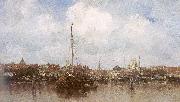 |
Maris, Jacob
|
|
Dutch, 1837-1899
was a Dutch painter, who with his brothers Willem and Matthijs belonged to what has come to be known as the Hague School of painters. Maris studied at the Antwerp Academy, and subsequently in Hubertus van Hove's studio during a stay in Paris from 1865 till 1871. He returned to Holland when the Franco-Prussian War broke out, and died there in August 1899. Though he painted, especially in early life, domestic scenes and interiors invested with deeply sympathetic feeling, it is as a landscape painter that Maris excelled. He was the painter of bridges and windmills, of old quays, massive towers, and level banks; even more was he the painter of water, and misty skies, and chasing clouds. In all his works, whether in water or oil color, and in his etchings, the subject is always subordinate to the effect. His art is suggestive rather than decorative, and his force does not seem to depend on any preconceived method, such as a synthetical treatment of form or gradations of tone. And yet, though his means appear so simple, the artist's mind seems to communicate with the spectator's by directness of pictorial instinct, and we have only to observe the admirable balance of composition and truthful perspective to understand the sure knowledge of his business that underlies such purely impressionist handling. Maris has shown all that is gravest or brightest in the landscape of Holland, all that is heaviest or clearest in its atmosphere for instance, in the " Grey Tower, Old Amsterdam," in the " Landscape near Dordrecht," in the " Sea-weed Carts, Scheven-ingen," in " A Village Scene," and in the numerous other pictures which have been exhibited in the Royal Academy, London, in Edinburgh (1885), Paris, Brussels |
|
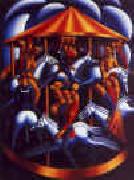 |
Mark Gertler
|
|
British
1891-1939
Mark Gertler Gallery
English painter. He was the son of Polish Jews and was brought up in Whitechapel in severe poverty until his father furrier workshop became moderately successful. As a child he knew nothing of art except advertisements and the work of pavement artists. He was 14 before he heard of any art institutions, and his career was determined by the discovery of W. P. Frith Autobiography in a secondhand bookshop. In 1906 he began attending art classes at the Regent Street Polytechnic in London, as well as a series of talks on Dutch and Flemish painting. His earliest still-lifes show the influence of Dutch 17th-century painting and the work of Chardin. Gertler left the Polytechnic for financial reasons in 1907 and apprenticed himself to Clayton and Bell, a firm of glass painters. In 1908 he won a prize in a national art competition and, on the strength of this, successfully applied for financial assistance from the Jewish Educational Aid Society, using William Rothenstein as a referee. That autumn he entered the Slade School of Fine Art, where he was taught by Henry Tonks and Philip Wilson Steer. He won several prizes and scholarships and fell in love with Dora Carrington. This and other friendships established at the Slade introduced him into a society that gave him a new perspective on his own family background. While writing delightedly to others of his nice friends among the upper classes, his paintings |
|
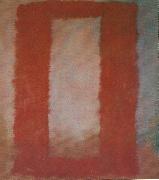 |
mark rothko
|
|
Mark Rothko, born Marcus Rothkowitz (September 25, 1903 - February 25, 1970), was a Russian-born American painter. He is classified as an abstract expressionist, although he himself rejected this label, and even resisted classification as an abstract painter. |
|
 |
mark tobev
|
|
Tropicalia, also known as Tropicalismo, is a Brazilian art movement that arose in the late 1960s and encompassed theatre, poetry, and music, among other forms. Tropicalia was influenced by poesia concreta (concrete poetry), a genre of Brazilian avant-garde poetry embodied in the works of Augusto de Campos, Haroldo de Campos, and Decio Pignatari, among a few others. However, Tropicalia is associated almost exclusively with the musical expression movement, both in Brazil and internationally, which arose from the fusion of several musical genres, like Brazilian and African rhythms and rock and roll. |
|
|
|
|
|
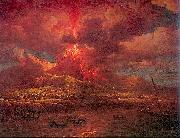 |
Marlow, William
|
|
English, 1740-1813
English painter. From c. 1756 to 1761 he was a pupil of Samuel Scott, the topographical and marine painter; he also studied at the St Martin's Lane Academy, London. Throughout his career Marlow made oils and watercolours of London views, for example Near Westminster Bridge, Evening (London, Guildhall A.G.), which shows his balanced, classical sense of composition, sensitivity to lighting effects and smooth handling of oil paint. Between 1765 and 1766 Marlow travelled in France and Italy, making numerous drawings of ruins, which provided the subjects for many paintings finished on his return to London. An Oxcart in the Grotto of Posillipo (c. 1770; New Haven, CT, Yale Cent. Brit. A.) exemplifies his bold, blue-toned watercolour style, with washes applied in loose blotches to emphasize the picturesque roughness of masonry and terrain. The handling has much in common with Canaletto, whom Marlow copied; a letter of 1771 from Horace Walpole to Sir Horace Mann (see 1956 exh. cat., p. 3) records that two views of Verona by Marlow were mistakenly sold as Canalettos. Marlow specialized in souvenirs of the Grand Tour, portraits of country houses, seascapes and river scenes. He visited many parts of Britain and Ireland in search of subjects, such as Powys Castle, Montgomeryshire (U. Manchester, Whitworth A.G.). |
|
|
|
 |
Marmion, Simon
|
|
French-born Flemish Northern Renaissance Painter, ca.1425-1489
French illuminator and painter. He was trained in Amiens and established a productive workshop in Valenciennes, but at the end of his career appears to have had connections with manuscript painting in the southern Netherlands. Although no signed or documented works survive, many illuminated manuscripts and some panel paintings have been convincingly attributed to him and his workshop. On the basis of these he has been recognized as an important figure in the development of both French and Netherlandish painting. |
|
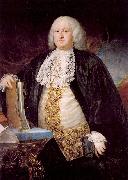 |
Maron, Anton von
|
|
Austrian, 1733-1808
Austrian painter. He studied at the Vienna Akademie and, in 1755, he went to Rome, where he was based for the rest of his life. From 1756 to 1761 he was first the pupil then the assistant of Anton Raphael Mengs. In 1765 he married Mengs's sister, the miniature painter Theresia Concordia Mengs. After collaborating on Mengs's fresco paintings in Rome (at S Eusebio and the Villa Albani; both in situ), Maron, working independently in Rome, spent some time on altar pictures (S Maria dell'Anima) and on various decorative projects. Mengs's influence is evident in Maron's ceiling pictures in the casino of the Villa Borghese (1784; in situ), where five paintings tell the Story of Aeneas and Dido in the style of quadri riportati, using clear construction, sharply defined drawing and a historical concept based on antiquity. Although he received many commissions for this type of work, Maron's true gifts lay in the field of portraiture. Along with Pompeo Batoni, Maron was the most celebrated portrait painter in 18th-century Rome, and he received an enormous number of commissions from princes, diplomats and church dignitaries and from English aristocrats visiting Rome as part of their Grand Tour. Maron painted such sitters in the same style as did Batoni, usually full-length and life-size, in elegantly fashionable dress, against backgrounds of Classical sculptures and views of Rome. Portraits such as those of Francis, Prince of Anhalt Dessau |
|
|
|
|
|
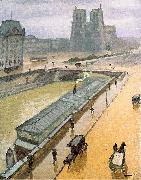 |
Marquet, Albert
|
|
French Fauvist Painter, 1875-1947
.French painter and draughtsman. In 1890 he was taken by his family to live in Paris so that he could study drawing at the Ecole Nationale Superieure des Arts Decoratifs. There he met Henri Matisse, with whom he formed a lasting friendship and with whom he studied from 1894 to 1898 at the Ecole des Beaux-Arts under Gustave Moreau. In the Louvre, Marquet made copies after Poussin, Velezquez, Claude Lorrain and particularly Chardin, of whose House of Cards he produced copies in 1894 and 1904 |
|
|
|
|
|
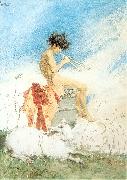 |
Marsal, Mariano Fortuny y
|
|
Spanish, 1838-1874
Painter and etcher. His work drew both on earlier Spanish art, especially the paintings and etchings of Goya, and on contemporary foreign works, notably the paintings of the Italian Macchiaioli and those of the French artist Ernest Meissonier. |
|
 |
Marsden Hartley
|
|
1877-1943
Marsden Hartley (January 4, 1877 - September 2, 1943) was an American Modernist painter and poet in the early 20th century. Hartley was born in Lewiston, Maine, USA. He began his art training at the Cleveland Institute of Art after moving to Cleveland, Ohio in 1892.
At the age of 22, he moved to New York City, where he attended the National Academy of Design and studied painting at the Art Students League of New York under William Merritt Chase. A great admirer of Albert Pinkham Ryder, Hartley would visit Ryder's studio in Greenwich Village as often as possible. While in New York, he came to the attention of Alfred Stieglitz and became associated with Stieglitz' 291 Gallery Group. Hartley had his first major exhibition at the 291 Gallery in 1909 and another in 1912. He was in the cultural vanguard, in the same milieu as Gertrude Stein, Hart Crane, Charles Demuth, Georgia O'Keeffe, Fernand Leger, Ezra Pound, among many others.
Hartley, who was gay, painted Portrait of a German Officer (1914), which was an ode to Karl von Freyburg, a Prussian lieutenant of whom he became enamored before von Freyburg's death in World War I. |
|
|
|
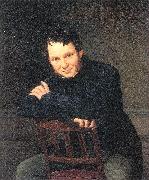 |
Marstrand, Wilhelm
|
|
Danish, 1810-1873
Danish painter and illustrator. He was a student of C. W. Eckersberg at the Kunstakademi in Copenhagen (1825-33). His art reflects his constant observation of the world around him, in particular middle-class society, and the narrative element dominated his pictures of crowds in the city streets. Throughout his life he sought inspiration from literature and the theatre. In his early genre painting Moving Day Scene (1831; Niv?, Nivaagaards Malsaml.) it was the popular novelty of vaudeville that interested him. The October Festival (1839; Copenhagen, Thorvaldsens Mus.) reveals how Marstrand's five-year stay (1836-41) in Italy opened his eyes to the classical ideal of beauty. It was, however, an ideal that found little response in contemporary Denmark, and he turned towards a more anecdotal and humorous approach. In Scene of Country Life (1843; Copenhagen, Kon. Dan. Kstakad.), painted as a set subject for the Kunstakademi, Marstrand took as his theme a scene from Erasmus Montanus, a play by the 18th-century Danish poet and playwright Ludvig Holberg. Thereafter Holberg's comedies provided an inexhaustible source that satisfied Marstrand's need to pursue his investigations of human character. Family life similarly interested him throughout his career, as in his Scene of Daily Life (1857; Copenhagen, Stat. Mus. Kst). Such group portraits as The Waagepetersen Family (1836; Copenhagen, Stat. Mus. Kst) show an equal concern to depict the quiet details of Danish domestic life. Marstrand continued to travel abroad in search of inspiration. His stay in Venice in 1853-4 was particularly important; his studies there of the great Venetian painters improved his understanding of the handling of colour, as seen clearly in the many historical and religious paintings of his last years. Of particular interest is his mural decoration of Christian IV's chapel in Roskilde Cathedral (1864-6) with scenes from the life of the Danish monarch. Marstrand's paintings have a certain facetiousness which often obscures a much deeper philosophical content. For this reason, it is his drawings that arouse more admiration. |
|
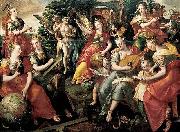 |
Marten de Vos
|
|
(1532-1603), also Maarten, was a leading Antwerp painter and draughtsman in the late sixteenth century.
|
|
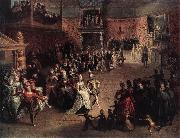 |
Marten Pepijn
|
|
Belgium (1575-1643 ) - Painter
Date of Birth: 1575
Date of Death: 1643 |
|
|
|
 |
Marten van Cleve
|
|
Flemish, 1527-1581,Brother of Hendrik van Cleve III. His presumed date of birth is derived from a document of 2 April 1567 in which he declared his age to be 40. In 1551-2 he became a master in the Antwerp Guild of St Luke and, according to van Mander, followed his brother into the studio of Frans Floris. If this is correct, it was probably c. 1553-5, for motifs drawn from Floris's work appear in Marten van Cleve's paintings executed during these years. Marten married Maria de Greve on 7 January 1556, apparently setting up his own studio at about the same time. Apprentices are regularly recorded from 1558 onwards, and it is probable that his own sons, Gillis II, Marten the younger, Joris and Nicolaas, also worked in the studio. Throughout the 1560s and 1570s Marten van Cleve's workshop was very productive, but the majority of works painted consisted of copies of his own originals. Van Mander's statement that the artist collaborated with a number of landscape painters, including his brother Hendrik III, Gillis van Coninxloo III, Gillis Mostaert and Jacob Grimmer, is confirmed by 17th-century inventories. |
|
 |
Martin Drolling
|
|
1752-1817
B.Oberbergheim
French Martin Drolling Art Gallery
After receiving initial training from an unknown painter in Selestat, Drolling moved to Paris, where he attended courses at the Academie Royale. He supplemented his education there by studying Flemish and Dutch Old Masters in the collection at the Luxembourg Palace. From the Flemish school he derived his own rich impasto, while the Dutch was to influence him in his meticulous, supremely descriptive and unsentimental style of painting as well as his choice of subject-matter: unfussy bourgeois interiors and frank portraits. Drolling first exhibited at the Salon de la Correspondance in 1781 and again in 1782 and 1789. After the French Revolution he was able to participate in the Salon at the Louvre, despite the fact that he had never become a member of the Academie Royale. He exhibited from 1793 to 1817, although the majority of his works extant today were shown after 1800. From 1802 to 1813 he was employed by the Sevres porcelain manufactory, and many of his designs were engraved. |
|
 |
Martin Archer Shee
|
|
RA (December 23, 1769 - August 13, 1850) was a British portrait painter and president of the Royal Academy.
He was born in Dublin, of an old Catholic Irish family, and his father, a merchant, regarded the profession of a painter as an unsuitable occupation for a descendant of the Shees. Martin Shee nevertheless studied art in the Dublin Society, and came to London. There, in 1788, he was introduced by William Burke to Joshua Reynolds, on whose advice he studied in the schools of the Royal Academy. In 1789 he exhibited his first two pictures, the "Head of an Old Man" and "Portrait of a Gentleman." Over the next ten years he steadily increased in practice. He was chosen an associate of the Royal Academy in 1798, in 1789 he married, and in 1800 he was elected a Royal Academician. He moved to George Romney's former house in Cavendish Square, and set up as his successor.
Shee continued to paint with great readiness of hand and fertility of invention, although his portraits were eclipsed by more than one of his contemporaries, and especially by Thomas Lawrence. The earlier portraits of the artist are carefully finished, easy in action, with good drawing and excellent discrimination of character. They show an undue tendency to redness in the flesh painting defect which is still more apparent in his later works, in which the handling is less "square," crisp and forcible. In addition to his portraits he executed various subjects and historical works, such as Lavinia, Belisarius, his diploma picture "Prospero and Miranda", and the "Daughter of Jephthah."
In 1805 he published a poem consisting of Rhymes on Art, and a second part followed in 1809. Lord Byron spoke well of it in his English Bards and Scotch Reviewers. Shee published another small volume of verse in 1814, entitled The Commemoration of Sir Joshua Reynolds, and other Poems, but this was less successful. He also produced a tragedy, Alasco, set in Poland. The play was accepted at Covent Garden, but was refused a licence, on the grounds that it contained treasonable allusions, and Shee angrily resolved to make his appeal to the public. He carried out his threat in 1824, but Alasco was still on the list of unacted dramas in 1911. He also published two novels - "Oldcourt" (1829, in 3 volumes) and "Cecil Hyde" (1834). |
|
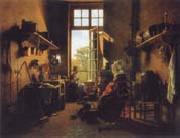 |
Martin Drolling
|
|
French Academic Painter, 1752-1817,After receiving initial training from an unknown painter in Selestat, Drolling moved to Paris, where he attended courses at the Acad?mie Royale. He supplemented his education there by studying Flemish and Dutch Old Masters in the collection at the Luxembourg Palace. From the Flemish school he derived his own rich impasto, while the Dutch was to influence him in his meticulous, supremely descriptive and unsentimental style of painting as well as his choice of subject-matter: unfussy bourgeois interiors and frank portraits. Drolling first exhibited at the Salon de la Correspondance in 1781 and again in 1782 and 1789. After the French Revolution he was able to participate in the Salon at the Louvre, despite the fact that he had never become a member of the Academie Royale. He exhibited from 1793 to 1817, although the majority of his works extant today were shown after 1800. From 1802 to 1813 he was employed by the Sevres porcelain manufactory, and many of his designs were engraved. |
|
|
|
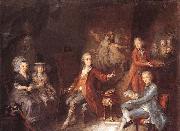 |
Martin Johann Schmidt
|
|
Austrian Painter, 1718-1801,was one of the most outstanding Austrian painters of the late Baroque/Rococo along with Franz Anton Maulbertsch. A son of the sculptor Johannes Schmidt and a pupil of Gottlieb Starmayr, he spent most of his life at Stein, where he mostly worked in the numerous churches and monasteries of his Lower Austrian homeland. While the evolution of his style after 1750 shows that he had either spent a formative period in northern Italy or had at least had extensive contact with northern Italian works of art prior to that date, his works are also clearly influenced by Rembrandt (visible above all in his etchings) and the great fresco-painters of the Austrian Baroque, Paul Troger and Daniel Gran. Despite not having received formal academic training, in 1768 he was made a member of the imperial academy at Vienna due to his artistic merits, which by that time had already been recognized by a wider public inside and outside of Austria. Primarily he painted devotional images for private devotion and churches, including a considerable number of large altar paintings. His lively and colourful style made him extremely popular with people from all levels of society already during his lifetime. From 1780 mythological and low-life themes became increasingly frequent, only to be replaced by a renewed concentration on religious topics during the very last years of Schmidt's life. He was at that an important draughtsman and has left numerous etchings which clearly show Rembrandt's influence. While his earlier works typically show a warm chiaroscuro, from about 1770 he used increasingly stronger and more lively colours. Simultanueously, both his style and his brush technique became much more free, making him, like Franz Anton Maulbertsch, an important predecessor of impressionism. In this aspect, his mature style is completely contrary to neoclassicism, the style which increasingly dominated European art after about 1780. |
|
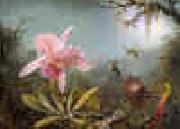 |
Martin Johnson Heade
|
|
American Hudson River School Painter, 1819-1904 Martin Johnson Heade (August 11, 1819-September 4, 1904) was a prolific American painter known for his salt marsh landscapes, seascapes, portraits of tropical birds, and still lifes. His painting style and subject matter, while derived from the romanticism of the time, is regarded by art historians as a significant departure from that of his peers.
Art historians have come to disagree with the common view that Heade is a Hudson River School painter, a view given wide currency by Heade's inclusion in a landmark exhibition of Hudson River School landscapes at the Metropolitan Museum of Art in 1987.
The leading Heade scholar and author of Heade's catalogue raisonn??, Theodore E. Stebbins, Jr., wrote some years after the 1987 Hudson River School exhibition that "...other scholars??myself included??have increasingly come to doubt that Heade is most usefully seen as standing within that school."
According to the Heade catalogue raisonn??, only around 40 percent of his paintings were landscapes. The remaining majority were still lifes, paintings of birds, and portraits, subjects unrelated to the Hudson River School. Of Heade's landscapes, perhaps only 25 percent were painted of traditional Hudson River School subject matter.
Heade had less interest in topographically accurate views than the Hudson River painters, and instead focused on mood and the effects of light. Stebbins writes, "If the paintings of the shore as well as the more conventional compositions...might lead one to think of Heade as a Hudson River School painter, the [marsh scenes] make it clear that he was not." |
|
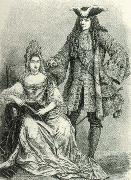 |
martin luther
|
|
Born: 10 November 1483
Birthplace: Eisleben, Germany
Died: 18 February 1546
Best Known As: German monk who started Protestant Reformation |
|
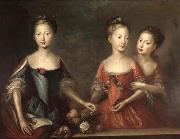 |
Martin Maingaud
|
|
Martin Maingaud (died 1725; fl.1692-c.1725) was a French portraitist.
|
|
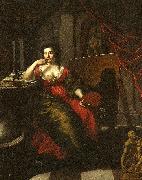 |
martin mijtens d.a
|
|
Martin Mijtens d.ä., Martin Meytens, Martin Mytens, född 1648 i Haag, Holland, död 1736 i Stockholm och begravd i Maria Kyrkan, nederländsk konstnär. Far till Martin Mijtens d.y. och son till porträttmålaren Isaac Mijtens.
Mijtens kom till Stockholm före eller under år 1677 och fann där ett så tacksamt fält för sin konst, att han beslöt stanna och 1681 satte han bo. Av hans första verk finns prov i Vibyholms och andra samlingar. De visar, att han hade en fin pensel, behaglig, varm, fastän tunn färg samt livlig och karakteristisk uppfattning av de skildrade. Med sina gråaktiga fonder, de ofta gulbruna draperierna och den enkla, naiva framställningen bildar Mijtens vid denna tid en bestämd motsats till David Klöcker Ehrenstrahl. Men dennes anseende och den gunst hans målningssätt vunnit var så stora, att även Mijtens måste böja sig. Så småningom blir hans bilder något anspråksfullare och djärvare, åtbörder och minspel kraftigare, bisakerna rikare, tonen i det hela mer högstämd, utan att personligheten försummas eller återgivningen av hudfärg överger den varma, åt gult dragande hållningen. Många bilder från denna hans andra period, som ungefär omfattar åren 1685- 1700, finns på Skoklosters slott, där Nils Bielke och hans grevinna, Eva Horn (i landskap), hör till mästarens bästa målningar, och på Vibyholm, i Uppsala (professor Schwedes porträtt i Uppsala museum och Olof Rudbeck d.ä.:s förträffliga bild, 1696, i medicinska fakultetens sessionsrum), i Hammers samling och på inte så få andra ställen. Konstnärens vana att högst sällan signera har gjort, att bilderna från dessa år ofta har blandats ihop med Ehrenstrahls och gått under den senares namn. Säkra skiljetecken är emellertid draperierna, som hos Mijtens saknar stil och ofta verkar tämligen slappt tecknade, och även det livligare åtbördsspelet. Man vet, att Mijtens, trots sin medtävlares anseende, var mycket eftersökt som porträttmålare och samlade förmögenhet på sin konst, så att han kunde bl.a. förvärva ett ej obetydligt konstgalleri. Han var även alltifrån 1692 och ganska länge kyrkoråd i den lilla holländska församlingen i Stockholm. 1697 och 1701 företog han resor till hembygden, den förra gången åtföljd av sin unge lärjunge Lucas von Breda. Utom denne ej obetydande konstnär utbildade Mijtens även sin son , som under det i Tyskland antagna namnet van Meytens berömde målaren (se denne), samt G. de Marees och möjligen flera. Man kan säga att omkring år 1700 vidtog Mijtens tredje maner. Karnationen får en dragning åt rött, som slutligen blir nästan stötande (t. ex. i Fabritius och prins Alexander av Georgiens porträtt på Gripsholms slott), teckningen vårdslösas mer, och de granna röda eller djupblå draperierna är stillösare och hårdare målade än förr. Dock lever ännu inte litet av den forna kraften i karaktärsteckningen, och anordningen bibehåller i mycket den förra prydligheten. Även denna hans nedgång finnes ej sällan företrädd i svenska samlingar. Märkligt är ett självporträtt (nu på Fånö i Uppland), emedan det enligt sägnen skall vara målat på hans höga ålderdom och under sinnessvaghet (om denna vet man för övrigt inget). Utom måleriet idkade han även gravyr samt utförde ett porträtt af Karl XI i svart maner och möjligen ett par andra blad i samma art (Gustaf Adolf de la Gardie, Georg Stiernhielm). Mijtens skall, enligt gammal uppgift, ha avlidit i Stockholm 1736; enligt en urkund levde han ännu i juli 1730. Hans målningssamling såldes av hans arvingar till preussiske överstemarskalken greve Gotter och kom inte långt därefter till storhertigen af Werttemberg. Carl Gustaf Tessin, som tycks ha hyst mycken ringaktning för Mijtens omtalar dock, att denna samling på sin tid ansågs som den enda framstående i riket (utom grefve Johan Gabriel Stenbocks). Att Carl Gustaf Tessin vid samma tillfälle kallar Mijtens "en gammal färgskämmare" och även annars talar illa om hans konst, tycks visa att Mijtens vid mitten af 1700-talet var fullkomligt bortglömd, åtminstone sådan han varit under sin bästa tid. Sedan finns han ej heller mycket omtalad. Först genom konstföreningens utställning 1841 och Nils Arfwidssons anmälan av honom i Frey återupptäcktes han; och man fann då, att Sverige i honom ägt en konstnär av sådan betydelse, att han kan mäta sig även med våra största mästare. Hans inflytande på den svenska konstens fortbildning blev dock ej särskilt stort. David Klöcker Ehrenstrahl och David von Krafft ställer honom i det avseendet fullkomligt i skuggan. |
|
|

